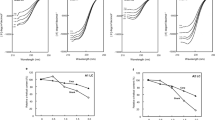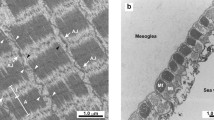Summary
We have used physicochemical and ultrastructural methods to investigate the effects of Ca2+ and ATP on the structure of purified heavy meromyosin (HMM) from the striated adductor muscle of the scallop, a species with myosin-linked regulation. Using papain as a structural probe, we found that, in the presence of ATP, the head/tail junction was five times more susceptible to digestion at high levels of Ca2+ than at low levels.wBy HPLC gel filtration, two fractions of scallop HMM with different Stokes radii were detected in the presence of ATP at low Ca2+, while at high Ca2+ a single peak with the larger Stokes radius predominated. Electron microscopy of rotary-shadowed HMM suggested that molecules with the smaller Stokes radius had their heads bent back towards their tails, while those with the larger radius had heads pointing away from the tail. The number of molecules with their heads bent back decreased at high Ca2+ levels. The data also showed that in the absence of ATP or at high salt, HMM molecules behaved similarly to those in the presence of ATP at high Ca2+.
These results suggest that scallop myosin heads can exist in two conformations (heads down towards the tail and heads up away from the tail) and that the equilibrium between these two conformations is altered by the concentrations of salt, ATP and Ca2+. However, the equilibrium between the two forms appears to be too slow to be involved in regulating contraction. The ‘heads-down’ configuration may instead be related to the inactive, folded (10S) form of scallop myosin and possibly involved in filament assembly during development.
Similar content being viewed by others
References
Adelstein, R. S. &Eisenberg, E. (1980) Regulation and kinetics of the actin-myosin-ATP interaction.Ann. Rev. Biochem. 49, 921–56.
Ankrett, R. J., Rowe, A. J., Cross, R. A., Kendrick-Jones, J. &Bagshaw, C. R. (1991) A folded (1OS) conformer of myosin from a striated muscle and its implications for regulation of ATPase activity.J. Mol. Biol. 217, 323–35.
Bennett, A. J., Patel, N., Wells, C. &Bagshaw, C. R. (1984) 8-analino-1-naphthalenesulphonate, a fluorescent probe for the regulatory light chain binding site of scallop myosin.J. Muscle Res. Cell Motil. 5, 165–82.
Castellani, L., Eliott, Jr, B. W., Winkelmann, D. A., Vibert, P. &Cohen, C. (1987) Myosin binding to actin; structural analysis using myosin fragments.J. Mol. Biol. 196, 955–60.
Chantler, P. D. &Szent-Györgyi, A. G. (1978) Spectroscopic studies on invertebrate myosins and light chains.Biochemistry 17, 5440–8.
Collins, J. H., Jakes, R., Kendrick-Jones, J., Leszyk, J., Barouch, W., Theibert, J. L., Spiegel, J. &Szent-Györgyi, A. (1986) Amino acid sequence of myosin essential light chain from the scallop Aequipecten irradians.Biochemistry 25, 7651–6.
Craig, R., Szent-Györgyi, A. G., Beese, L., Flicker, P., Vibert, P. &Cohen, C. (1980) Electron microscopy of thin filaments decorated with a Ca2+-regulated myosin.J. Mol. Biol. 140, 35–55.
Craig, R., Smith, R. &Kendrick-Jones, J. (1983) Light chain phosphorylation controls the conformation of vertebrate non-muscle and smooth muscle myosin molecules.Nature (Lond.)302, 436–9.
Craig, R., Padrón, R. &Kendrick-Jones, J. (1987) Structural changes accompanying phosphorylation of tarantula muscle myosin filaments.J. Cell Biol. 105, 1319–27.
Elliott, A. &Offer, G. (1978) Shape and flexibility of the myosin molecule.J. Mol. Biol. 123, 505–19.
Flicker, P. F., Wallimann, T. &Vibert, P. (1983) Electron microscopy of scallop myosin: location of regulatory light chains.J. Mol. Biol. 169, 723–41.
Frado, L.-L. Y. &Craig, R. (1988) Structural changes induced in scallop HMM by Ca2+ and ATP.Biophys. J. 53, 177a.
Frado, L.-L. Y. &Craig, R. (1989) Structural changes induced in Ca2+-regulated myosin filaments by Ca2+ and ATP.J. Cell Biol. 109, 529–38.
Hardwicke, P. M. D., Wallimann, T. &Szent-Györgyi, A. G. (1983) Light-chain movement and regulation in scallop myosin.Nature (Lond.) 301, 478–82.
Hardwicke, P. M. D. &Szent-Györgyi, A. G. (1985) Proximity of regulatory light chains in scallop myosin.J. Mol. Biol. 183, 203–11.
Highashihara, M., Frado, L.-L. Y., Craig, R. &Ikebe, M. (1989) Inhibition of conformational change in smooth muscle myosin by a monoclonal antibody against the 17-kDa light chain.J. Biol. Chem. 264, 5218–25.
Ikebe, M. &Ogihara, S. (1982) Phosphorylation-dependent and ATP-induced changes in structural array in gizzard myosin filament bundles.J. Biochem. (Tokyo) 92, 1973–7.
Ikebe, M. &Hartshorne, D. J. (1984) Conformation-dependent proteolysis of smooth-muscle myosin.J. Biol. Chem. 259, 11639–42.
Ikebe, M., Hinkins, S. &Hartshorne, D. J. (1983) Correlation of enzymatic properties and conformation of smooth muscle myosin.Biochemistry 22, 4580–7.
Jackson, A. P., Warriner, K. E., Wells, C. &Bagshaw, C. R. (1986) The actin-activated ATPase of regulated and unregulated scallop heavy meromyosin.FEBS Lett. 197, 154–8.
Kendrick-Jones, J. &Scholey, J. M. (1981) Myosin-linked regulatory systems.J. Muscle Res. Cell Motil. 2347–72.
Kendrick-Jones, J., Lehman, W. &Szent-GYörgyi, A. G. (1970) Regulation in molluscan muscles.J. Mol. Biol. 54, 313–26.
Kendrick-Jones, J., Jakes, R., Tooth, P., Craig, R. &Scholey, J. (1982) Role of the myosin light chain in the regulation of contractile activity. InBasic Biology of Muscles: A Comparative Approach (edited by Twarog, B. M., Levine, R. J. C. & Dewey, M. M.) pp. 255–72. New York: Raven Press.
Laemmli, U. K. (1970) Cleavage of structural proteins during the assembly of the head of bacteriophage T4.Nature (London) 227, 680–5.
Laurent, T. C. &Killander, J. (1964) A theory of gel filtration and its experimental verification.J. Chromatog. 14, 317–30.
Lehman, W. &Szent-Györgyi, A. G. (1975) Regulation of muscular contraction. Distribution of actin control and myosin control in the animal kingdom.J. Gen. Physiol. 66, 1–30.
Lowey, S., Slayter, H. S., Weeds, A. G. &Baker, H. (1969) Substructure of the myosin molecule. I. Subfragments of myosin by enzymic degradation.J. Mol. Biol. 42, 1–29.
Margossian, S. S. &Lowey, S. (1982) Preparation of myosin and its subfragments from rabbit skeletal muscle.Methods Enzymol. 85, 55–71.
Matsudaira, P. T. &Burgess, D. R. (1978) SDS microslab linear gradient polyacrylamide gel electrophoresis.Anal. Biochem. 87, 386–96.
Onishi, H. &Watanabe, S. (1984) Correlation between the papain digestibility and the conformation of 10S-myosin from chicken gizzard.J. Biochem. (Tokyo) 95, 899–902.
Schacterle, G. R. &Pollack, R. L. (1973) A simplified method for the quantitative assay of small amounts of protein in biological material.Anal. Biochem. 51, 654–5.
Sellers, J. R. (1981) Phosphorylation-dependent regulation of Limulus myosin.J. Biol. Chem. 256, 9274–8.
Sherry, J. M. F., Gorecka, A., Aksoy, M. O., Dabrowska, A. R. &Hartshorne, D. J. (1978) Roles of calcium and phosphorylation in the regulation of the activity of gizzard myosin.Biochemistry 17, 4411–18.
Shpetner, H. (1985) Structural and regulatory properties of scallop heavy meromyosin. PhD Thesis, Brandeis University.
Sobieszek, A. (1977) Vertebrate smooth muscle myosin enzymatic and structural properties. InThe Biochemistry of Smooth Muscle (edited by Stephens, N. L.) pp. 413–43. Baltimore-London-Tokyo: University Park Press.
Spudich, J. A. &Watt, S. (1971) The regulation of rabbit skeletal muscle contraction.J. Biol. Chem. 246, 4866–71.
Stafford, W. F., III, Szentkiralyi, E. M. &Szent-GYörgyi, A. G. (1979) Regulatory properties of single-headed fragments of scallop myosin.Biochemistry 18, 5273–80.
Suzuki, H., Stafford, W. F., III, Slayter, H. S. &Seidel, J. C. (1985) A conformational transition in gizzard heavy meromyosin involving the head-tail junction, resulting in changes in sedimentation coefficient, ATPase activity and orientation of heads.J. Biol. Chem. 260, 14 810–17.
Suzuki, H., Kondo, Y., Carlos, A. D. &Seidel, J. C. (1988) Effects of phosphorylation, MgATP, and ionic strength on the rates of papain degradation of heavy and light chains of smooth muscle heavy meromyosin at the S1-S2 junction.Biol. Chem. 263, 10 974–9.
Szent-Györgyi, A. G., Szentkiralyi, E. M. &Kendrick-Jones, J. (1973) The light chains of scallop myosin as regulatory subunits.J. Mol. Biol. 74, 179–203.
Szentkiralyi, E. M. (1984) Tryptic digestion of scallop S1: evidence for a complex between the two light chains and a heavy chain peptide.J. Muscle Res. Cell Motil. 5, 147–64.
Trybus, K. M. &Lowey, S. (1984) Conformational states of smooth muscle myosin.J. Biol. Chem. 259, 8564–71.
Trybus, K. M., Huiatt, T. W. &Lowey, S. (1982) A bent monomeric conformation of myosin from smooth muscle.Proc. Natl. Acad. Sci. USA 79, 6151–5.
Tyler, J. M. &Branton, D. (1980) Rotary shadowing of extended molecules dried from glycerol.J. Ultrastruct. Res. 71, 95–102.
Vibert, P. &Craig, R. (1983) Electron microscopy and image analysis of myosin filaments from scallop striated muscle.J. Mol. Biol. 165, 303–20.
Vibert, P. &Craig, R. (1985) Structural changes that occur in scallop myosin filaments upon activation.J. Cell Biol. 101, 830–7.
Vibert, P. &Cohen, C. (1988) Domains, motions and regulation in the myosin head.J. Muscle Res. Cell Motil. 9, 296–305.
Vibert, P. &Castellani, L. (1989) Substructure and accessory proteins in scallop myosin filaments.J. Cell Biol. 109, 539–47.
Walker, M. &Trinick, J. (1988) Visualization of domains in native and nucleotide-trapped myosin heads by negative staining.J. Muscle Res. Cell Motil. 9, 359–66.
Wallimann, T. &Szent-Györgyi, A. G. (1981) An immunological approach to myosin light-chain function in thick filament linked regulation. 2. Effect of anti-scallop myosin light-chain antibodies. Possible regulatory role for the essential light chain.Biochemistry 20, 1188–97.
Wallimann, T., Hardwicke, P. M. D. &Szent-Györgyi, A. G. (1982) Regulatory and essential light-chain interactions in scallop myosin. II. Photochemical cross-linking of regulatory and essential light-chains by heterobifunctional reagents.J. Mol. Biol. 156, 153–73.
Wells, C. &Bagshaw, C. R. (1984) The Ca2+ sensitivity of the actin-activated ATPase of scallop heavy meromyosin.FEBS Lett. 168, 260–4.
Wells, C. &Bagshaw, C. R. (1985) Calcium regulation of molluscan myosin ATPase in the absence of actin.Nature (Lond.) 313, 696–7.
Wells, C., Warriner, K. E. &Bagshaw, C. R. (1985) Fluorescence studies on the nucleotide- and Ca2+-binding domains of molluscan myosin.Biochem. J. 231, 31–8.
Winkelmann, D. A., Almeda, S., Vibert, P. J. &Cohen, C. (1984) A new myosin fragment: visualization of the regulatory domain.Nature (Lond.) 307, 758–60.
Author information
Authors and Affiliations
Rights and permissions
About this article
Cite this article
Young Frado, LL., Craig, R. Structural changes induced in scallop heavy meromyosin molecules by Ca2+ and ATP. J Muscle Res Cell Motil 13, 436–446 (1992). https://doi.org/10.1007/BF01738038
Received:
Revised:
Accepted:
Issue Date:
DOI: https://doi.org/10.1007/BF01738038




